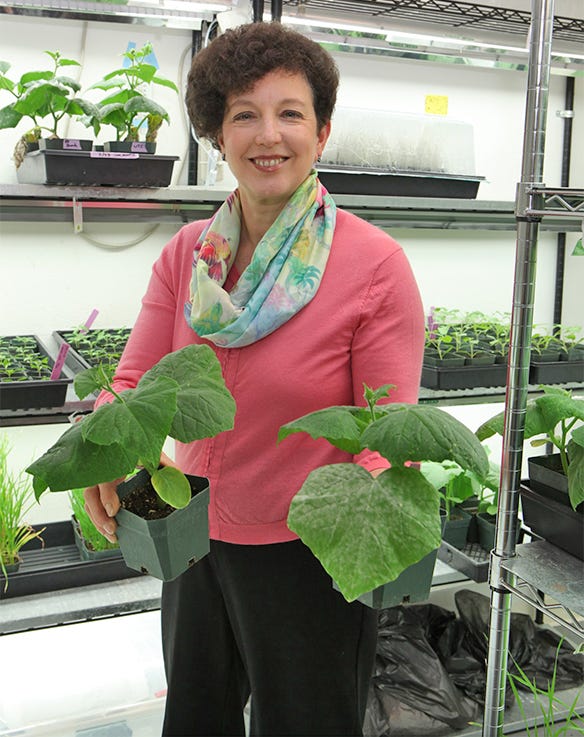December 11, 2017

Pam Marrone is energetic, innovative and frustrated. She’s the founder and background force for Marrone Bio Innovations, a Davis, Calif., firm that has been a trendsetter in a growing area of technology: biologicals.
And why is Marrone frustrated? Because environmentalists and regulators start talking about banning a traditional crop protection product, but never consider ways to bring alternatives to work on the issues, she says. For example, there’s talk of banning chlorpyrifos in crops. This is a potent, and long-used, insecticide. Yet MBI has a bio-based product that has been shown in trials to outperform the older chemistry in a wide range of trials. Why not go bio?
“What’s never done is a discussion of weaning out of a product,” Marrone tells Farm Progress. “Biologicals could be a help, but it’s on no one’s radar. This is a potential for a paradigm shift.”

BIOLOGICALS INNOVATOR: Pam Marrone, Marrone Bio Innovations, says biologicals can meet a wide range of crop protection challenges. (Photo courtesy of Marrone Bio Innovations)

What she’s suggesting is that if a product is deemed to have an environmental impact, instead of starting with an outright ban, regulators should consider a more integrated pest management approach. “They can come up with an approach that uses biologicals in combination with the traditional product to reduce the number of sprays of the [older] chemical over time — say, a three-year period,” she says.
That approach helps growers maintain their confidence they’re getting control as they become familiar with the new bio-based product. “You eventually get to a replacement, but the process isn’t immediate,�” Marrone says.
And she’s confident that there’s a biological solution for every one of those problems. From controlling diseases in crops to taking out problem weeds, biologicals can do the job.
The chlorpyrifos-replacing biological from Marrone is Venerate. “It’s actually an insect growth regulator with a new mode of action,” she explains. “We discovered it, and it’s a bacteria — actually a dead bacteria and a cocktail of compounds from that bacteria.”
That bug-killing cocktail keeps insect pests from developing. Once on the back of a lygus bug, thrip or other pest, that insect just stops developing. The product is sprayed like a traditional chemical, and Marrone says it’s equaled or beat out chlorpyrifos in trials around the globe — from alfalfa to onions, bananas to coffee.
Biologicals and the future
With Venerate, the bacteria are dead, which means there’s no concern about keeping it alive to do its job in the field. That’s often a concern about biologicals: coming up with formulations that keep the living pest control product working.
“Stability is a concern. We have to make sure that our products will be effective,” she explains. “You look at the stability of the natural chemistry, and we have to work for those that are stable enough for at least a three-year shelf life.”
As for that “step-down” approach from traditional chemistry to biologicals, Marrone is concerned that this new-tech approach isn’t part of the regulatory conversation — yet. “We’re seeing the same thing with every problematic chemical. Something is to be eventually banned, but there is a more measured way to do it that’s also beneficial to farmers,” she says.
But are there shortcomings to using biologicals? There is sometimes a perception of weaker efficacy; it’s not if they work, though, it’s how to make them work. You have to understand their mode of action to properly use them in integrated programs. “We’ve found many biologicals, and we know there are so many microbes out there that we can find a solution for anything if we screen enough. We have a first-generation herbicide in development now.”
That product is a novel bacteria that can actually move in the plant systemically — though it is not as mobile as a product like glyphosate. Marrone says the product kills Palmer amaranth, redroot pigweed, lambsquarters and some grasses.
One benefit of the biological approach is that products can be brought to market more quickly. That means that the first version of a biological can go to market, while a more powerful second version is in development and can be available a couple of seasons later.
Along the way the biological formulator — such as MBI — works on product cost and efficacy to keep upping the ante against the target pest. “I think herbicides are the next wave of biologicals as well,” she says. “We’re one of the only companies that has a product. It’s very technically challenging. There have been no new herbicides and no new modes of action. We’ve discovered three so far.”
And there’s more. Stargus is a new biofungicide coming to market in 2018. For now it’s coming to specialty crops, but row crops are in the product’s future. Along with antifungal compounds that stop spore germination, the microbe populates on the plant root hairs, leaves and other surfaces, preventing establishment of fungal and bacterial pathogens. Marrone says it’s effective against Fusarium, Sclerotinia, Botrytis, Rhizoctonia and sclerotium. While only in specialty crops to start, she sees potential for white mold prevention in soybeans and other row crops, too.
The world of biological crop controls is opening up, and more discoveries are on the way. The next step is to get regulators to see the value of phasing in new approaches in combination with traditional crop protection products to help farmers, rather than simply take tools away.
If you want to know more, visit marronebioinnovations.com.
About the Author(s)
You May Also Like






